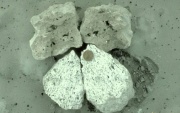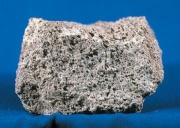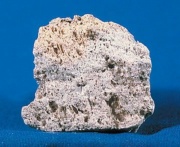Difference between revisions of "Pumice"
(username removed) |
|||
| (5 intermediate revisions by 2 users not shown) | |||
| Line 1: | Line 1: | ||
[[File:Pumice_USGS.jpg|thumb|Pumice]] | [[File:Pumice_USGS.jpg|thumb|Pumice]] | ||
== Description == | == Description == | ||
| − | |||
| − | |||
| − | |||
[[File:Pumiceemr1.jpg|thumb|Pumice]] | [[File:Pumiceemr1.jpg|thumb|Pumice]] | ||
| + | A pale gray, porous variety of the volcanic stone [[rhyolite|rhyolite]]. Pumice is composed of potassium aluminum silicate with small amounts of [[iron|iron]] and [[alkali|alkalis]]. Its spongy texture is due to numerous cavities formed by gas bubbles that were trapped when the stone solidified. The stone is lightweight enough to float on [[water|water]] for months. Pumice is used as an [[abrasive|abrasive]] for polishing jewelry, cleaning metals, and smoothing [[vellum|vellum]] and [[parchment|parchment]]. It has also been used as a clear glaze on stoneware, as a matting agent and as a coarsening agent for texturizing painted surfaces. Pumice was quarried in ancient times from the Greek islands of Melos and Nisyros. Current production comes from Italy (Lipari Islands), Greece, Turkey, Spain, and the United States. | ||
| + | [[File:Pumiceemr2.jpg|thumb|Pumice]] | ||
== Synonyms and Related Terms == | == Synonyms and Related Terms == | ||
rhyolite; volcanic glass; Bimsstein (Deut.); Bims (Deut.); piedra pómez (Esp.); pierre ponce (Fr.); pedra-pomes (Port.); elafropetra (Gr.); pomice (It.); puimsteen (Ned.) | rhyolite; volcanic glass; Bimsstein (Deut.); Bims (Deut.); piedra pómez (Esp.); pierre ponce (Fr.); pedra-pomes (Port.); elafropetra (Gr.); pomice (It.); puimsteen (Ned.) | ||
| + | == Risks == | ||
| − | == | + | * Contains silica. Inhalation of dust may cause silicosis. |
| + | == Physical and Chemical Properties == | ||
| − | Insoluble in water and solvents. Floats on water. | + | * Insoluble in water and solvents. Floats on water. |
| − | + | * Ground pumice has angular broken particles with visible broken bubbles | |
| − | Ground pumice has angular broken particles with visible broken bubbles | ||
{| class="wikitable" | {| class="wikitable" | ||
| Line 23: | Line 23: | ||
| 1.50 | | 1.50 | ||
|} | |} | ||
| − | |||
| − | |||
| − | |||
| − | |||
| − | |||
== Comparisons == | == Comparisons == | ||
| − | [[media: | + | [[media:download_file_209.pdf|Properties of Common Abrasives]] |
| − | |||
| − | |||
| − | == | + | ==Resources and Citations== |
* R. J. Gettens, G.L. Stout, ''Painting Materials, A Short Encyclopaedia'', Dover Publications, New York, 1966 Comment: RI = 1.50 | * R. J. Gettens, G.L. Stout, ''Painting Materials, A Short Encyclopaedia'', Dover Publications, New York, 1966 Comment: RI = 1.50 | ||
| Line 55: | Line 48: | ||
* ''The Merck Index'', Martha Windholz (ed.), Merck Research Labs, Rahway NJ, 10th edition, 1983 Comment: entry 8127 | * ''The Merck Index'', Martha Windholz (ed.), Merck Research Labs, Rahway NJ, 10th edition, 1983 Comment: entry 8127 | ||
| − | * ''Encyclopedia Britannica'', http://www.britannica.com Comment: "Pumice." | + | * ''Encyclopedia Britannica'', http://www.britannica.com Comment: "Pumice." Accessed 12 May 2004. |
* Art and Architecture Thesaurus Online, http://www.getty.edu/research/tools/vocabulary/aat/, J. Paul Getty Trust, Los Angeles, 2000 | * Art and Architecture Thesaurus Online, http://www.getty.edu/research/tools/vocabulary/aat/, J. Paul Getty Trust, Los Angeles, 2000 | ||
Latest revision as of 14:29, 22 October 2022
Description
A pale gray, porous variety of the volcanic stone Rhyolite. Pumice is composed of potassium aluminum silicate with small amounts of Iron and alkalis. Its spongy texture is due to numerous cavities formed by gas bubbles that were trapped when the stone solidified. The stone is lightweight enough to float on Water for months. Pumice is used as an Abrasive for polishing jewelry, cleaning metals, and smoothing Vellum and Parchment. It has also been used as a clear glaze on stoneware, as a matting agent and as a coarsening agent for texturizing painted surfaces. Pumice was quarried in ancient times from the Greek islands of Melos and Nisyros. Current production comes from Italy (Lipari Islands), Greece, Turkey, Spain, and the United States.
Synonyms and Related Terms
rhyolite; volcanic glass; Bimsstein (Deut.); Bims (Deut.); piedra pómez (Esp.); pierre ponce (Fr.); pedra-pomes (Port.); elafropetra (Gr.); pomice (It.); puimsteen (Ned.)
Risks
- Contains silica. Inhalation of dust may cause silicosis.
Physical and Chemical Properties
- Insoluble in water and solvents. Floats on water.
- Ground pumice has angular broken particles with visible broken bubbles
| Mohs Hardness | 6.0-6.5 |
|---|---|
| Refractive Index | 1.50 |
Comparisons
Properties of Common Abrasives
Resources and Citations
- R. J. Gettens, G.L. Stout, Painting Materials, A Short Encyclopaedia, Dover Publications, New York, 1966 Comment: RI = 1.50
- G.S.Brady, Materials Handbook, McGraw-Hill Book Co., New York, 1971 Comment: p. 640
- Ralph Mayer, A Dictionary of Art Terms and Techniques, Harper and Row Publishers, New York, 1969 (also 1945 printing)
- R.M.Organ, Design for Scientific Conservation of Antiquities, Smithsonian Institution, Washington DC, 1968
- Matt Roberts, Don Etherington, Bookbinding and the Conservation of Books: a Dictionary of Descriptive Terminology, U.S. Government Printing Office, Washington DC, 1982
- Jack Odgen, Jewellery of the Ancient World, Rizzoli International Publications Inc., New York City, 1982
- Van Nostrand's Scientific Encyclopedia, Douglas M. Considine (ed.), Van Nostrand Reinhold, New York, 1976
- R.F.Symmes, T.T.Harding, Paul Taylor, Rocks, Fossils and Gems, DK Publishing, Inc., New York City, 1997
- The Merck Index, Martha Windholz (ed.), Merck Research Labs, Rahway NJ, 10th edition, 1983 Comment: entry 8127
- Encyclopedia Britannica, http://www.britannica.com Comment: "Pumice." Accessed 12 May 2004.
- Art and Architecture Thesaurus Online, http://www.getty.edu/research/tools/vocabulary/aat/, J. Paul Getty Trust, Los Angeles, 2000
- Janet Burnett Grossman, Looking at Greek and Roman Sculpture in Stone, J. Paul Getty Trust, Los Angeles, 2003
- Michael McCann, Artist Beware, Watson-Guptill Publications, New York City, 1979
- Ceramics and Glass Conservation Section, List of Workshop Materials, The British Museum, London
- Conservation Support Systems, Catalog, 1997


